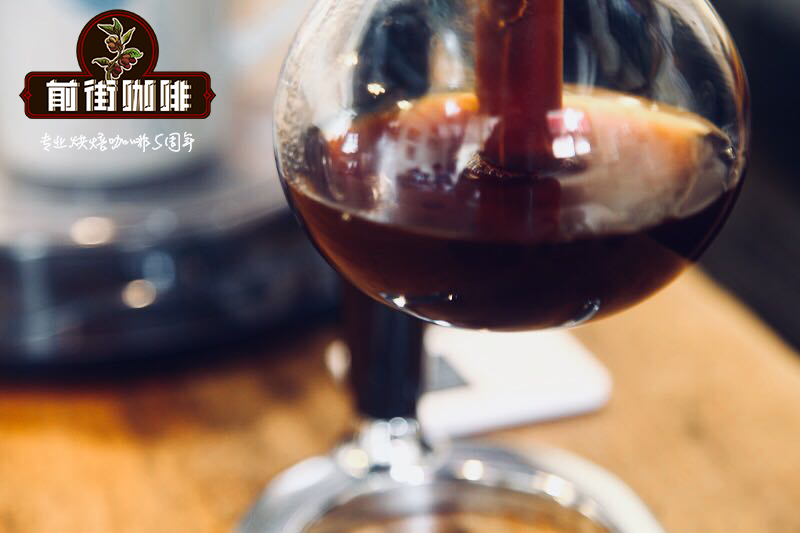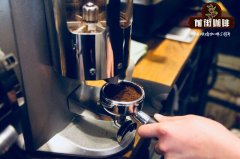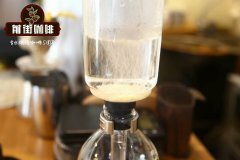Share the experience of siphon pot brewing: how to use siphon pot and what kind of coffee is suitable for siphon pot

Professional coffee knowledge exchange More coffee bean information Please pay attention to coffee workshop (Weixin Official Accounts cafe_style)
I've been making coffee for about five years.
Siphon pots for the first three years.
I'm not good for seniority.
But I still want to write what I have learned and realized
Because writing is about sharing.
And I read a lot of articles about siphoning "teaching."
A lot of people just know what they're doing and don't know why.
I am more motivated to write this article.
The reason I use the word "share"
not "teaching."
Because I think coffee drinking is subjective.
Coffee too.
You have to use the word teaching to mean you think your way is completely correct
You're good enough to teach.
There are many "correct" brewing methods circulating in the market
however
In addition to the basic steps of ignition & water addition
All parameters are adjustable.
i.e.
The right way does not exist!
It doesn't matter if it exists.
Because what we need
is to cook it to your liking.
therefore
Everyone has their own way.
for me
Making coffee is like an experiment.
is a scientific
As long as it's intentional.
As long as you understand how each of your subtle adjustments can make a difference in taste
No one can say, hey, you're cooking it wrong.
When you can fully understand what each step can do to the taste of coffee, you can make the most of it
Coffee brewing will be from science
into art,
Next, let's see how I cook.
My cooking is simple.
Boil the water--grind the beans--stir after boiling to the top--powder--stir to mix the coffee powder and water evenly--turn off the heat about 60 seconds after the powder contacts the water--stir--pull the pot
And finally, a cup of self-flowing coffee.
It looks pretty sketchy.
But there's a lot we can talk about.
One at a time.
While we boil the water, we grind the beans.
siphon teaching
First, we will discuss grinding and extraction time.
There are many genres in the market
Some people will use very fine grinding + 15-25 seconds for rapid extraction
Some people use coarse grinding + 1.5-2.5 minutes slow extraction
As I said before,
That's everybody's method. These are all methods. It doesn't matter whether they are right or wrong.
The key points are:
Control each powder to be evenly mixed with water, not to over-extract or under-extract
Personally, I use the medium grind shown above with a 60-second extraction
(Compared to the other two, it is called medium grinding, which is about coarser than granulated sugar)
60 seconds is a benchmark for my brewing.
I will adjust the time of the next brewing according to the taste of the cooking
If it feels bitter or too strong, it may be that I have extracted too much or the water temperature is too high.
If you think it is too light and the water taste is very heavy, you can increase the amount of powder or extend the time.
(I recommend using the former, as extending the extraction time does not help when there is a real shortage of powder rather than insufficient extraction time)
I've also seen a lot of experts so-called smelling and observing powder precipitation to determine whether sufficient extraction has been achieved
But I personally don't think that's for everyone.
Especially for someone new to coffee.
I would suggest cooking it according to time first.
After all, the thickness and time of coffee powder are both controllable conditions
Smells like enough extraction, it's experience.
We can smell and remember the taste every time we brew
And analyze the correlation between what you smell and what you drink.
To enhance their judgment and experience points
Don't rush to smell when you can't make a cup of coffee that tastes stable
Cook every day, smell every day
Soon you'll understand the connection.
you can
Or grind the beans before cooking as much as possible
That's how you get the taste of coffee.
Otherwise, as time goes by,
The carbon dioxide in coffee powder spreads with its mellow taste & umami taste
All you get is a dead cup of coffee.
And then there's water.
Some people emphasize the benefits of hard water.
of course
It's possible to cook it in mineral-rich water, which might improve the taste a little bit.
But hard water is not readily available.
I've seen serious shops electrolyze water before they make coffee.
But I personally can't do it, and I don't recommend it.
Unless you have a really, really sensitive palate.
Or do you think that's how you make a good cup of coffee?
Then do what you want.
And since this isn't something everyone can do,
Personally, I think it's natural
Convenience oriented
As long as the water doesn't smell bad.
It usually cooks without problems.
And then we're going to go into the brewing phase.
While grinding the beans, you can add water to the pot on the lower seat and insert it into the upper seat.
From the picture above, we can discuss three problems
first
Notice the color of the filter cloth?
It's not a new filter cloth.
The cleanliness of filter cloth also has a great influence on coffee taste
If the filter cloth isn't clean
The brewed coffee will have a mixed taste and even a smell of oil
Just smelling it makes you want to feed it to the sink.
That led to the development of filter paper filters
siphon teaching
Although it doesn't feel that green.
But he did manage to minimize the impact of the filter cloth on the coffee.
Here's one more thing to add
What we saw in the filter cloth project
Either negative impact (dirty filter cloth) or find a way to achieve no impact (filter paper)
Is there a filter for extra points?
The answer is yes!
I wrote about a coffee shop before-Elbow Coffee
They use KONO siphons.
The biggest characteristic of this pot was not that he could buy three pots from others!
It's his three-dimensional ceramic filter.
Based on how you feel about it,
This design does add a little bit of roundness.
But is it worth the extra money?
That's up to you.
the second question
We see that the upper seat in the photo is directly inserted into the lower seat (Method 1)
Do not hang it aside until the water boils (Method 2)
It's not like you put it on the lower seat until the water boils.
(Method 3, this cooking method is the most common)
What is the difference between these three ways?
In fact, the first and third methods are OK.
The difference is, if we start with the top seat on the bottom seat,
Before the water boils, a little warm water runs into the seat
If you are using the "grind and pour directly into the seat" method in brewing coffee
So the first method is easy to overextract
Coffee begins to extract the moment it touches the water.
Who cares if your water boils?
That's why more people use the third method.
And that's what I did two years before I started cooking.
Until I read an article written by a senior.
It says: ... water must accumulate a considerable amount of heat in order to be able to rush from the lower seat to the upper seat, and therefore the water that has just rushed into the upper seat is extremely hot, far higher than our ideal brewing temperature..."
And according to my own Shennong experiments,
The conclusion reached is consistent with the previous statement
If you put the ground powder on the upper seat at the beginning, wait until the water boils and put it directly into the lower seat.
And the coffee that comes out of it
Bring the water to a boil and pour in the ground coffee.
The taste is bitter and the level is weak.
therefore
I started changing the procedure.
as for
Method 2: No matter whether there is coffee powder in the seat, hang the seat aside and wait for the water to boil before putting it down
It's dangerous!
This method is prone to sudden boiling phenomenon, resulting in the upper seat and hot water upward spray
It's not a mystery.
It's strictly forbidden.
Although many restaurants still like to cook like this
But for security reasons,
I advise against trying.
Third question, we talked about fire.
Most commercial corks come with an alcohol lamp.
I cooked it with an alcohol lamp in the early days.
There's nothing wrong with that.
It's just a little slow.
It is a little difficult to control the size of the flame
After boiling to the upper seat, the temperature of the lower seat must be controlled by constantly moving the source of fire.
later
Switch to a small gas stove.
In this way, the source of fire can be controlled more accurately.
We can also save our spirit for smelling incense.
To remember the relationship between the aroma of coffee and the degree of extraction.
The water is boiled from the lower seat to the upper seat
Is to stir.
About stirring
Everyone has different methods.
Some people are used to drawing clockwise circles
Some people prefer counterclockwise.
There are also people who do not draw circles and take the route of stirring back and forth.
These are all OK.
The point is
We should stir in such a way that every coffee powder can interact with water.
That is, to achieve uniform extraction.
My method is born out of thinking about this problem.
It is put forward here for your reference.
Don't add powder when the water is boiled to the top seat.
Stir the water into a whirlpool first
Siphon teaching
Siphon teaching
The purpose of this is twofold.
First, it is necessary to lower the excessively high temperature slightly.
Second, such a whirlpool can make coffee powder mix with water more quickly after adding powder.
Then drop the powder.
From the photo, you can see that the powder at the bottom will be sucked down into the whirlpool.
That's why I have to stir it first.
Then the powder floating on the water is stirred back and forth and pressed down into the water.
Finally, the circle of the clock is reversed.
This is what I did after my personal experiment.
In terms of the experimental results,
The taste cooked in this way is more "stable" than that of simply drawing a circle.
You can also try it on your own.
The first stirring is complete.
If the beans are fresh enough
After stirring, you will see that the upper seat is divided into three layers.
From top to bottom: foam, coffee powder, water
Siphon teaching
Beans that are not fresh or ground for too long will not have the top foam.
And after the results of my Shennong's research,
Coffee without top foam will taste a little less delicious.
You can smell it when the coffee powder is mixed with water and is in such a steady state.
It has something to do with the taste after cooking.
There is a school of saying:
What you smell is what you drink, and it changes over time.
(that is, it varies with the degree of extraction)
The result of my actual experience also confirms this.
Aroma and taste are closely related.
Turn off the fire for about 60 seconds after the powder comes into contact with water-- stir--
Finally do the action of pulling the pot.
Wrap the upper edge of the lower seat in a wet rag
Siphon teaching
The purpose of this action is to reduce the negative effect of overtime brewing on coffee.
For example, the appearance of miscellaneous taste and astringent taste
So the sooner you can pull the coffee out of the upper seat, the better.
I've seen people trying to achieve this.
Put the wet rag in the freezer
Boil it and pull the pot.
I think the effect must be good!
But this is accompanied by the risk that the lower seat will crack due to rapid changes in temperature.
I would suggest that it is better to use two wet rags to fight in turn.
In the part of pulling the pot, there is also a wonderful idea to talk to you about.
There is a saying that:
When you pull the pot, you can see that the golden foam in the picture below means that the coffee is good and the coffee is good.
According to my actual visit to various stores & my own cooking experience
I'll tell you.
It makes no difference whether there is a golden bubble or not.
I've had coffee that makes golden foam but doesn't taste good.
I have also had a good drink without foam.
Other manipulation conditions are far more important than this golden bubble!
NEO_IMG_DSC_5623.jpg
In fact, there is also a stunt called "inverted water" in the part of pulling the pot.
Meaning refers to:
After boiling to the upper seat, there will still be a little bit of water left in the lower seat, while many experts or people who think it has an impact on the taste will pull out the upper seat before pulling the pot, pour out the water quickly, and insert the upper seat back into the upper seat. do the act of pulling the pot.
As I am not good at learning, I never dare to try.
So I don't know whether this action is useful in terms of my own experience.
Leave it to everyone to try.
Finish flushing and cooking
People who stir around the circle should look at this hill.
Siphon teaching
There is a saying that it is right to have a hill in the upper seat after the cooking is finished & the standard practice.
I'll tell you from my personal experience.
I have never boiled a hill since I first brewed coffee in plug wind.
But
I still make bad coffee at 05:00.
So this argument is really very weak.
For people who stir back and forth.
It is impossible to appear in a hill!
But the coffee made by these people is delicious.
Okay
What I'm really trying to say is
"this is a bluff."
I've been writing this article for weeks.
It's been revised, it's been increasing.
A seemingly simple process
"boil the water-grind the beans-stir until the water reaches the upper seat-drop the powder-stir so that the coffee powder is evenly mixed with water-turn off the heat for about 60 seconds after the powder comes into contact with the water-stir-pull the pot
Finally, there is a cup of self-flowing coffee. "
In fact, it can be fastidious & there are many places to control.
Making coffee is a science.
It is the result of continuous experiments.
Okay
That's all I have to say.
To have a cup of coffee in peace.
Important Notice :
前街咖啡 FrontStreet Coffee has moved to new addredd:
FrontStreet Coffee Address: 315,Donghua East Road,GuangZhou
Tel:020 38364473
- Prev

The History of Italian Coffee Machine the cold knowledge about Italian coffee machine can not be found
Professional coffee knowledge exchange more coffee bean information please follow the coffee workshop (Wechat official account cafe_style) I do not know who first wrote this paragraph: at the beginning of the 20th century, an impatient engineer living near Napoli, Italy, was impatient with dripping coffee for too long, so he was waiting for time to come up with a way to make coffee with high temperature and high pressure.
- Next

Experience of siphon pot brewing coffee siphon pot experience and practical tips
Professional coffee knowledge exchange more coffee bean information please follow the coffee workshop (Wechat official account cafe_style) if you have read the diary friends should notice that I recently in addition to the previous hand coffee, but also a tool to extract coffee. This thing is a siphon pot, but the name we might hear is siphon coffee. This one is accurate.
Related
- What is the Philharmonic pressure? How to use Philharmonic pressure to make delicious coffee
- Why does a hand grinder have more fine powder than an electric grinder?
- In addition to the hot mom, what is the difference between the versions of EK43 | ditting and Mahdi ek43?
- What kind of equipment do you need to make coffee by hand? Introduction to novice starter cooking equipment tools
- Espresso needs to be ground how thick and thin scale entry Italian Coffee Machine Bean Grinder investigation and Grinding course
- How much does it cost to open a small private cafe? How much does it cost to learn coffee? How to operate it?
- The difference between the flavor characteristics of hand-brewed coffee and coffee maker is hand-brewed coffee really better than coffee maker? Can I use a coffee machine to make coffee beans by hand?
- The difference between 01 and 02 of hario v60 filter cup what is the difference between 01 and 02 filter cup opening and cooking flavor
- What's the difference between the smart cup and the French kettle? Which is better, the French kettle or the Smart Cup?
- What's the difference between a smart cup and a V60 filter cup? The difference between the taste of smart cup and hand-brewed coffee

